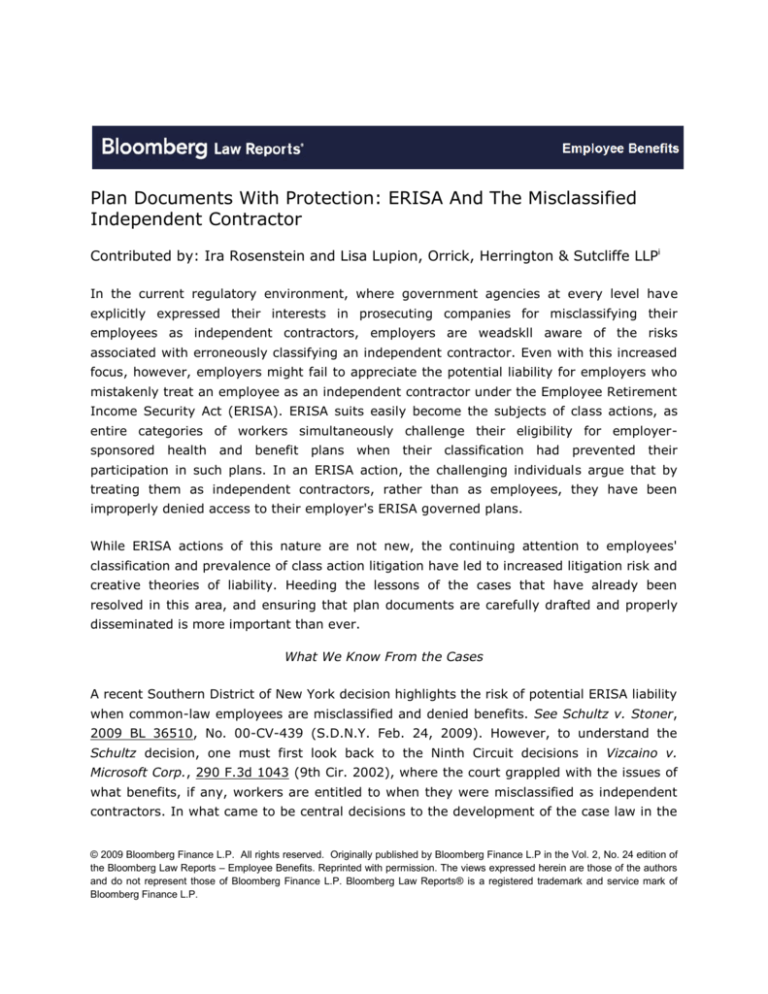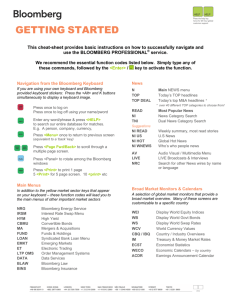
Plan Documents With Protection: ERISA And The Misclassified
Independent Contractor
Contributed by: Ira Rosenstein and Lisa Lupion, Orrick, Herrington & Sutcliffe LLPi
In the current regulatory environment, where government agencies at every level have
explicitly expressed their interests in prosecuting companies for misclassifying their
employees as independent contractors, employers are weadskll aware of the risks
associated with erroneously classifying an independent contractor. Even with this increased
focus, however, employers might fail to appreciate the potential liability for employers who
mistakenly treat an employee as an independent contractor under the Employee Retirement
Income Security Act (ERISA). ERISA suits easily become the subjects of class actions, as
entire categories of workers simultaneously challenge their eligibility for employersponsored
health
and benefit
plans when their classification had
prevented
their
participation in such plans. In an ERISA action, the challenging individuals argue that by
treating them as independent contractors, rather than as employees, they have been
improperly denied access to their employer's ERISA governed plans.
While ERISA actions of this nature are not new, the continuing attention to employees'
classification and prevalence of class action litigation have led to increased litigation risk and
creative theories of liability. Heeding the lessons of the cases that have already been
resolved in this area, and ensuring that plan documents are carefully drafted and properly
disseminated is more important than ever.
What We Know From the Cases
A recent Southern District of New York decision highlights the risk of potential ERISA liability
when common-law employees are misclassified and denied benefits. See Schultz v. Stoner,
2009 BL 36510, No. 00-CV-439 (S.D.N.Y. Feb. 24, 2009). However, to understand the
Schultz decision, one must first look back to the Ninth Circuit decisions in Vizcaino v.
Microsoft Corp., 290 F.3d 1043 (9th Cir. 2002), where the court grappled with the issues of
what benefits, if any, workers are entitled to when they were misclassified as independent
contractors. In what came to be central decisions to the development of the case law in the
© 2009 Bloomberg Finance L.P. All rights reserved. Originally published by Bloomberg Finance L.P in the Vol. 2, No. 24 edition of
the Bloomberg Law Reports – Employee Benefits. Reprinted with permission. The views expressed herein are those of the authors
and do not represent those of Bloomberg Finance L.P. Bloomberg Law Reports® is a registered trademark and service mark of
Bloomberg Finance L.P.
area of ERISA and independent contractors, Vizcaino reached the Ninth Circuit twice, where
a panel first determined that the wrongly classified independent contractors were entitled to
ERISA benefits, and an en banc panel later modified that determination.
In the case's first trip to the Ninth Circuit, the court analyzed Microsoft's ERISA plans, which
defined the term "employee" as "any common-law employee who receives remuneration for
personal services rendered to the employer and who is on the United States payroll of the
employer." Vizcaino, 97 F.3d 1187, 1192 (9th Cir. 1996). At the time of the appeal, it was
undisputed that the plaintiffs were common-law employees, as determined by the Internal
Revenue Service. Id. at 1192-93. Thus, the issue for the court to determine was whether
the term "on United States payroll" excluded the common-law employee plaintiffs from
coverage, as Microsoft suggested. The Ninth Circuit rejected Microsoft's contention that the
phrase meant to cover only those common-law employees paid through the payroll
department, rather than individuals paid through accounts receivable like the plaintiffs. Id.
at 1195. The court concluded that there was no evidence that Microsoft intended to
distinguish between common-law employees based upon the manner in which they were
paid. Id. Rather, the only reason that Microsoft failed to offer the plaintiffs access to its
ERISA benefits plan was because of Microsoft's erroneous contention that these individuals
were independent contractors. Id. The Ninth Circuit therefore concluded that the plaintiffs
were eligible to participate in the plan. Notably, the court also determined that the fact that
Microsoft did not intend to provide independent contractors with benefits was irrelevant, as
the inquiry was whether Microsoft intended to provide benefits to those persons who were
actually common-law employees but were not known to be such. Id. at 1195.
When the Ninth Circuit revisited Vizcaino, it determined that because the ERISA plan's
administrator never determined that the plaintiffs were excluded pursuant to the "on the
United States payroll" language, the court's analysis of that language was premature.
Vizcaino, 120 F.3d 1006, 1013 (9th Cir. 1997) (en banc). The court recommended,
however, that the plan administrator should pay "careful attention" to the court's previous
decision, suggesting that the court did not abdicate its earlier analysis. Id. The en banc
panel also addressed the fact that each of the plaintiffs entered into an agreement with
Microsoft, stating that he or she was an independent contractor and was therefore
responsible for his or her own insurance and benefits. Id. at 1010-13. The court concluded
that just as the statements in these agreements suggesting that the workers were
employees and that Microsoft was not responsible for tax withholdings have failed, the
statements regarding the plaintiffs' disclaimer of benefits must also fail. Id. at 1013.
© 2009 Bloomberg Finance L.P. All rights reserved. Originally published by Bloomberg Finance L.P in the Vol. 2, No. 24 edition of
the Bloomberg Law Reports – Employee Benefits. Reprinted with permission. The views expressed herein are those of the authors
and do not represent those of Bloomberg Finance L.P. Bloomberg Law Reports® is a registered trademark and service mark of
Bloomberg Finance L.P.
The teaching of the Vizcaino decisions is not that all individuals deemed to be common-law
employees are automatically entitled to their employer's ERISA benefits, but that such
individuals can be entitled to such benefits depending on how the plan defines eligibility.
See Curry v. CTB McGraw Hill, LLC, 296 Fed. Appx. 563, No. 06-CV-15397 (9th Cir. Oct. 9,
2008) ("[W]e have not held that all common law employees are entitled to benefits under
ERISA . . . , [i]nstead we look to the terms of the plans at issue to determine who is entitled
to coverage."). Accordingly, in the aftermath of Vizcaino, it is clear that the specific
language contained within the plan documents is integral to resolving ERISA cases, and, in
fact, is often dispositive of the outcomes of the case. See Oplchenski v. Parfums Givenchy,
Inc., No. 05-CV-6105 (N.D. Ill. Feb. 19, 2009) (distinguishing Vizcaino and holding that "the
critical issue for determining whether or not a worker is entitled to benefits under ERISA
plans is how the plans define eligible employees").
The recent Schultz decision provides a poignant example of the import of the specific
terminology used in the plan documents. In Schultz, the plaintiffs performed services for
Texaco entities, but were on payroll of certain temporary agencies. These third-party
contractors entered into agreements with Texaco to provide them with "contract personnel"
or "extra labor personnel services." While these individuals were on the payrolls of the thirdparty contractors they did not receive any benefits under any of the employee benefits
plans.
However,
notwithstanding
their
technical
employment
with
the
third-party
contractors, Texaco supervised the plaintiffs on a day-to-day basis, had the right to hire and
fire them, paid the plaintiffs fixed salaries, and furnished their offices, office furniture,
computers, telephones, and other supplies. With this factual background the court analyzed
the exclusion of these individuals under the terms of the benefit plans in 1989, and then
under the amended language contained in the 1994 plans.
The court first concluded that the plaintiffs were unable to assert a claim under the 1989
plans, despite the fact that "the conclusion that [plaintiffs] were independent contracts is
not consistent with the record or the law." The 1989 plans provided that "Employees whose
services are received by a participating Employer pursuant to a leasing agreement between
the participating Employer and a third party shall not be deemed within a classification of
eligible employees." Thus, because it was undisputed that plaintiffs' services were provided
pursuant to third-party contracts, the court deferred to the plan's determination to exclude
plaintiffs from coverage.
By removing the "third party contract" exclusion language from the plan documents with the
1994 amendments, however, the court reached the opposite conclusion. In the amended
plan, Texaco excluded persons "characterized by or under contract with the Employer as an
© 2009 Bloomberg Finance L.P. All rights reserved. Originally published by Bloomberg Finance L.P in the Vol. 2, No. 24 edition of
the Bloomberg Law Reports – Employee Benefits. Reprinted with permission. The views expressed herein are those of the authors
and do not represent those of Bloomberg Finance L.P. Bloomberg Law Reports® is a registered trademark and service mark of
Bloomberg Finance L.P.
independent contractor." With this changed language the court determined that the
determination that the plaintiffs were ineligible under this plan was both arbitrary and
capricious. The court held that given the fact that the plaintiffs did not contract directly with
Texaco, and that the plaintiffs were at all times subject to Texaco's direction and
supervision at work, were paid regular predetermined salaries, and were provided all
necessary tools and equipment, there was no legal or factual foundation to exclude plaintiffs
from coverage under the 1994 plan. The court also highlighted the fact that the specific plan
language allowed the employer to determine independent contract status, but there was no
evidence before the plan that the term "independent contractor" was used in the third-party
contracts or in the personnel file materials. Thus, the court explained that "ERISA requires
that plans be administered in accordance with their terms," and "[t]he terms of the plan
here at issue do not exclude workers solely on the basis of employment with Third Party
Contractor payrolls."ii
Other post-Vizcaino cases that demonstrate the premier importance of well-drafted, precise
plan documents include:
• Bendsen v. George Weston Bakeries Distribution, Inc., 2008 BL 216258, No. 09-CV-50
(E.D. Mo. Sept. 26, 2008): The ERISA plan document provided that the term "employee"
did not include any individual who "(i) is subject to an agreement, signed by the
individual, which provides that the individual has no claim to any benefits paid by the
Employer to or for the benefit of its employees, or (ii) without regard to any retroactive
change in treatment, is contemporaneously treated by the Employer for federal tax
purposes as other than a common law employee through issuance of a Form 1099 rather
than a Form W-2." The plaintiffs had signed distribution agreements where they agreed
that they were independent contractors for all purposes, and expressly disavowed any
claim to benefits or compensation paid to employees. The court, reading the distribution
agreements in connection with the plan documents, determined that, regardless of
whether the plaintiffs were common-law employees, the plaintiffs were not entitled to
benefits under the plan.
• Nahoun v. Employees' Pension Plan of Credit Suisse First Boston, No. 04-CV-9221
(S.D.N.Y. June 22, 2005): Within the plan documents, the term "employee" was defined
as "any person employed by the Corporation or a Participating Affiliate and treated as
such on the books and records of the Corporation or Participating Affiliate, and shall not
include (i) any person treated by the Corporation or Participating Affiliate as an
independent contractor or (ii) any person serving the Corporation or Participating Affiliate
through an agency, consulting firm, payroll service, subcontractor or other third party
© 2009 Bloomberg Finance L.P. All rights reserved. Originally published by Bloomberg Finance L.P in the Vol. 2, No. 24 edition of
the Bloomberg Law Reports – Employee Benefits. Reprinted with permission. The views expressed herein are those of the authors
and do not represent those of Bloomberg Finance L.P. Bloomberg Law Reports® is a registered trademark and service mark of
Bloomberg Finance L.P.
provider." The court determined that because the plan failed to define "books and
records" and because the plaintiff identified certain records (distribution lists, certain
compliance records) where he was considered an employee, the court not exclude the
possibility that the plaintiff was an employee under the plan. The court also denied the
defendant's argument that the plaintiff was "treated as an independent contractor" within
the meaning of the plan documents, as plaintiff proffered evidence that he was
designated as, but never treated like, an independent contractor.
What To Learn From the Caselaw
Several principles can be drawn from the case law that will allow employers to manage the
risk of an ERISA suit by allegedly misclassified employees.
First, employers must clearly define the term "employee" in all of their plan documents. An
employers' failure to articulate who it considers to be its "employees" that are eligible for
benefits leaves such an employer totally exposed in the event that they have not properly
classified a worker, or more likely, a class of workers. If faced with a plan that does not
define the term "employee," courts will apply the multi-factored common-law test to
determine benefit eligibility,iii and the employer no longer has any control over who is
eligible for benefits. Alternatively, there is no potential liability for excluding a worker from
ERISA benefits even if that individual is an employee. See, e.g., Curran v. Fedex Ground
Package System, Inc., 593 F. Supp. 2d 341, 344 (D. Mass. 2009) (explaining that "it is not
the case that employees are necessarily participants in a plan" as employers do not have to
make the plans available to all employees (citing Kolling v. American Power Conversion
Corp., 347 F.3d 11, 14 (1st Cir. 2003)).
Second, employers need to use consistent terminology in all of their plan documents, and in
their employment policies and procedures. If an employer intends to exclude a category of
workers from its ERISA plans, it should define eligibility in the same manner in all of those
plans. Employers must also be sure not to overlook the manner in which that category of
workers is described in offer letters, contracts or agreements, handbooks or other policies,
compliance materials, personnel files, and payroll data. Discrepancies between the
description of workers in a benefits plan and the description of those same workers in other
employer-maintained files can prevent a court from dismissing a case, even if the plan
documents themselves are well drafted.
Third, it is imperative that employers use terminology that is consistent with their actual
business practices and procedures. Just as an employer's use of inconsistent language in
© 2009 Bloomberg Finance L.P. All rights reserved. Originally published by Bloomberg Finance L.P in the Vol. 2, No. 24 edition of
the Bloomberg Law Reports – Employee Benefits. Reprinted with permission. The views expressed herein are those of the authors
and do not represent those of Bloomberg Finance L.P. Bloomberg Law Reports® is a registered trademark and service mark of
Bloomberg Finance L.P.
their plan documents can create ambiguities that preclude dismissing an action, a
disconnect between the language in the plan documents and the way that the employer
actually operates can undermine the definitions in the plan. If, for example, an employer
excludes from their ERISA plans those individuals retained through a third-party contract,
the employer must be sure that the workers are actually hired through such a contract, and
that the plan defines the proper parties to the agreement. Similarly, the use of an
independent contractor agreement with a worker is not likely to be sufficient to exclude that
worker from coverage, even if the worker disclaims benefits coverage in the contract, unless
the plan explicitly references the agreement. Moreover, rather than using general
statements, such as excluding from coverage those individuals "treated as independent
contractors," it is better practice for an employer to tie the definition to an actual practice or
procedure it applies to those individuals, such as issuing a Form 1099.
Finally, while employers can manage the risks associated with misclassification, no amount
of careful drafting can replace the thoughtful classification of workers in the first place.
Employers
should
periodically
re-examine
those
workers
classified
as
independent
contractors to ensure that their classifications are consistent with the current state of the
law. Equally important to the development of the law, is the evolution of the workers'
position. What was originally a clear independent contractor relationship can transform into
an employment relationship over time. Employers should not rest upon a theory that once
an independent contractor, always an independent contractor, as neither the government
agencies nor the plaintiffs' bar are examining a worker's situation as it once was.
_____________________________________________
i
Ira Rosenstein, a partner in the New York office and a member of the firm's Employment
Law Group, has spent the last 18 years at Orrick counseling and regularly and successfully
defending employers in arbitration and litigation before state and federal courts and
arbitration tribunals. In addition to representing both large and small employers in
traditional employment disputes involving claims of discrimination, wrongful discharge,
violation of federal and state wage-and-hour laws and Sarbanes-Oxley whistleblower claims
over the past five years, Mr. Rosenstein has taken more than 20 employment-related
arbitrations to final decision before FINRA (formerly the NASD and NYSE) and the American
Arbitration Association.
Mr. Rosenstein's practice is diverse, running from complex counsel and litigation over
deferred compensation and commission plans, ERISA litigation, claims brought under the
NLRA and FLSA and state law wage-and-hour class actions to disputes brought under Title
© 2009 Bloomberg Finance L.P. All rights reserved. Originally published by Bloomberg Finance L.P in the Vol. 2, No. 24 edition of
the Bloomberg Law Reports – Employee Benefits. Reprinted with permission. The views expressed herein are those of the authors
and do not represent those of Bloomberg Finance L.P. Bloomberg Law Reports® is a registered trademark and service mark of
Bloomberg Finance L.P.
VII and the New York State and City Human Rights Laws. Mr. Rosenstein also regularly
partners with our corporate attorneys to provide advice and counsel on employment and
labor issues stemming from mergers and acquisitions and other corporate transactions as
well as advising generally on executive compensation and the hiring and in some cases
departures of senior executives or key employees.
Mr. Rosenstein has expertise in New York wage-and-hour issues, including audits and
preventative approaches for avoiding class action and other litigation under the FSLA and
New York Labor Law. He is the longtime editor and author of the New York Chapter of the
BNA's Wage-and-Hour treatise and speaks regularly on the subject. Regardless of the size
of the client or representation, Mr. Rosenstein prides himself on providing the kind of
practical, no nonsense and efficient representation clients deserve and rightly demand.
Mr. Rosenstein's recent clients include Citi, Morgan Stanley, Delta Air Lines, Credit Suisse,
Newsweek, Apple, AES, PLI, Icahn Associates, Genentech, Gymboree, Triad Radio
Broadcasting, Goldman Sachs, ACF Industries, Movado, iVillage and the Papert Companies.
Ira can be reached at (212) 506-5228 or irosenstein@orrick.com.
Lisa Lupion, an associate in Orrick's New York office, is a member of the Employment Law
Group. Ms. Lupion's practice focuses on general employment law matters. Prior to joining
Orrick, Ms. Lupion served as a law clerk to the Hon. Peter Leisure in the United States
District Court for the Southern District of New York, and she was an associate at Proskauer
Rose LLP in New York. Lisa can be reached at (212) 506-5078 or llupion@orrick.com.
ii
The Schultz case was further complicated by the fact that the Texaco plan administrators
never provided plaintiffs with the 1994 amendments in a timely way. Initially, the court had
determined that the plaintiffs claims were time barred because they learned of their
erroneous classification in 1990 or 1991 but failed to bring suit until 2000, which was
beyond the six-year statute of limitations. However, the court reconsidered and reversed
that decision based on the fact that the Texaco plan administrators never provided
information regarding the plan amendments and plaintiff therefore "had no reason to
suspect that any changes in the plans' terms might have been made that could have
affected their ability to assert claims for benefits." Thus, the court concluded "[t]o hold that
their time to assert such claims had begun to run three years before the changes were ever
made, and ran out before they ever learned of the changes, would be to permit plan
sponsors and administrators to conceal benefit plans or improvements from their employees
and then invoke the statute of limitations as a bar to payment of the benefits if the
employees ever managed to learn of them. Such a holding would be contrary to the spirit of
© 2009 Bloomberg Finance L.P. All rights reserved. Originally published by Bloomberg Finance L.P in the Vol. 2, No. 24 edition of
the Bloomberg Law Reports – Employee Benefits. Reprinted with permission. The views expressed herein are those of the authors
and do not represent those of Bloomberg Finance L.P. Bloomberg Law Reports® is a registered trademark and service mark of
Bloomberg Finance L.P.
ERISA's provisions requiring timely and accurate disclosure of plan terms to participants and
beneficiaries and defeat the purpose of the civil action provisions of the statute, which give
persons with colorable claims to benefits the right to press those claims in court."
iii
As the Supreme Court explained "[i]n determining whether a hired party is an employee
under the general common law of agency, we consider [1] the hiring party's right to control
the manner and means by which the product is accomplished. Among the other factors
relevant to this inquiry are [2] the skill required; [3] the source of the instrumentalities and
tools; [4] the location of the work; [5] the duration of the relationship between the parties;
[6] whether the hiring party has the right to assign additional projects to the hired party;
[7] the extent of the hired party's discretion over when and how long to work; [8] the
method of payment; [9] the hired party's role in hiring and paying assistant; [10] whether
the work is part of the regular business of the hiring party; [11] whether the hiring party is
in business; [12] the provision of employee benefits; and [13] the tax treatment of the
hired party." Nationwide v. Darden, 503 U.S. 318, 323–24 (1992) (internal citations
omitted).
© 2009 Bloomberg Finance L.P. All rights reserved. Originally published by Bloomberg Finance L.P in the Vol. 2, No. 24 edition of
the Bloomberg Law Reports – Employee Benefits. Reprinted with permission. The views expressed herein are those of the authors
and do not represent those of Bloomberg Finance L.P. Bloomberg Law Reports® is a registered trademark and service mark of
Bloomberg Finance L.P.




